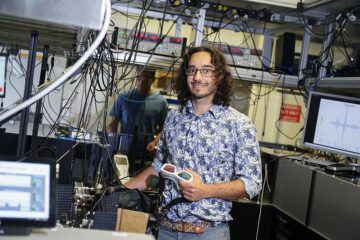Delving into defects spurs prospects for chip insulator

A warm winter coat doesn’t work nearly as well if it’s full of holes. The same is true for hafnium oxide, a promising insulator for the next generation of smaller, faster microchips.
While hafnium oxide prevents currents from leaking through the ultrathin layers of semiconductor chips more than 1,000 times better than conventional silicon oxide, its prospects have been dampened by too many current-draining defects.
Now a team of National Institute of Standards and Technology (NIST) and IBM researchers reports in the March edition of Electron Device Letters that they have quantified these „electrical capture defects“ in a way that may help chipmakers reduce the defects or at least devise a way around them.
NIST researcher John S. Suehle called the team’s measurements a „critical first step“ for improving manufacturing processes.
Using a method called „charge pumping,“ the NIST and IBM scientists found where the defects occur near the interface between the silicon substrate and the hafnium oxide and how those locations are ultimately detrimental to transistor operation. The method involves applying a voltage pulse and then measuring the current coming from a transistor. By changing the characteristics of the voltage pulse used, the scientists were able to measure the electrical-capture capacity of the defects.
Media Contact
Weitere Informationen:
http://www.nist.gov/Alle Nachrichten aus der Kategorie: Materialwissenschaften
Die Materialwissenschaft bezeichnet eine Wissenschaft, die sich mit der Erforschung – d. h. der Entwicklung, der Herstellung und Verarbeitung – von Materialien und Werkstoffen beschäftigt. Biologische oder medizinische Facetten gewinnen in der modernen Ausrichtung zunehmend an Gewicht.
Der innovations report bietet Ihnen hierzu interessante Artikel über die Materialentwicklung und deren Anwendungen, sowie über die Struktur und Eigenschaften neuer Werkstoffe.
Neueste Beiträge

Neue universelle lichtbasierte Technik zur Kontrolle der Talpolarisation
Ein internationales Forscherteam berichtet in Nature über eine neue Methode, mit der zum ersten Mal die Talpolarisation in zentrosymmetrischen Bulk-Materialien auf eine nicht materialspezifische Weise erreicht wird. Diese „universelle Technik“…

Tumorzellen hebeln das Immunsystem früh aus
Neu entdeckter Mechanismus könnte Krebs-Immuntherapien deutlich verbessern. Tumore verhindern aktiv, dass sich Immunantworten durch sogenannte zytotoxische T-Zellen bilden, die den Krebs bekämpfen könnten. Wie das genau geschieht, beschreiben jetzt erstmals…

Immunzellen in den Startlöchern: „Allzeit bereit“ ist harte Arbeit
Wenn Krankheitserreger in den Körper eindringen, muss das Immunsystem sofort reagieren und eine Infektion verhindern oder eindämmen. Doch wie halten sich unsere Abwehrzellen bereit, wenn kein Angreifer in Sicht ist?…





















